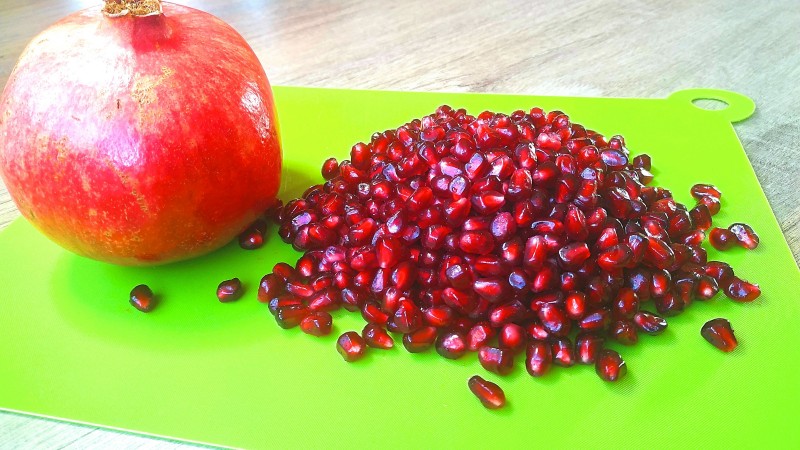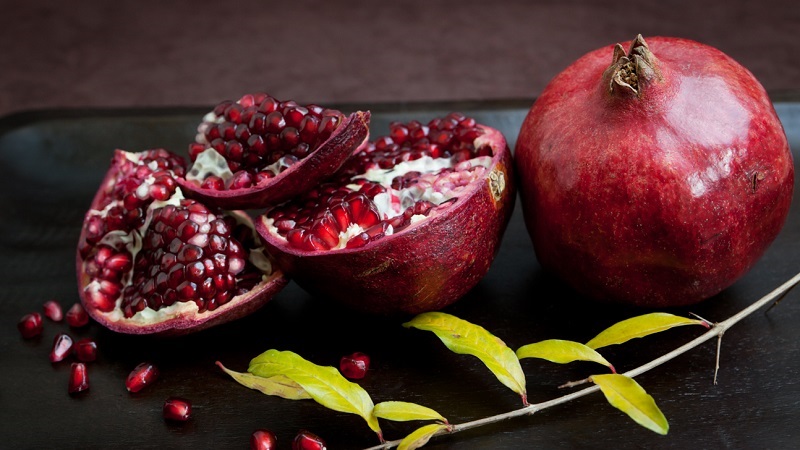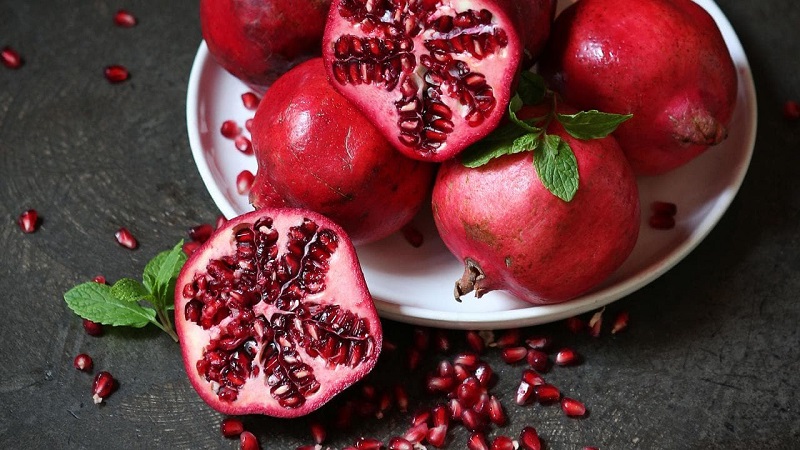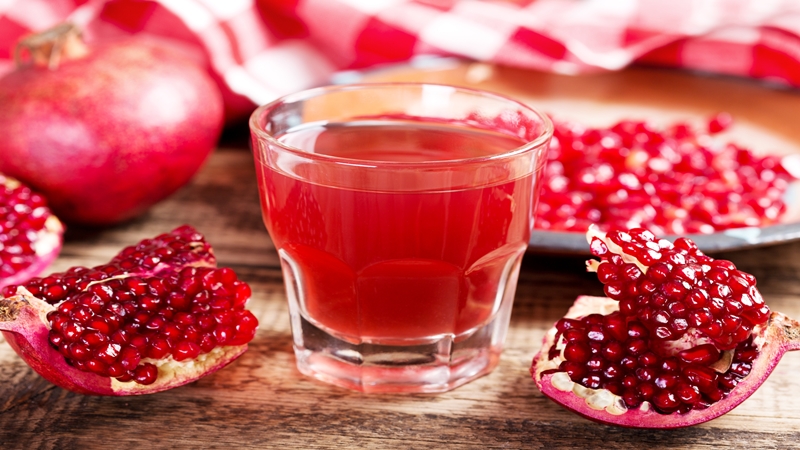How to eat pomegranate (with or without seeds): life hacks for easy peeling
“Small, round, but inside there are red beads” - this is how the Armenian riddle describes the king of fruits. Another name for the titled berry fruit is a heavenly, or granular, apple, and not just an apple, but precisely the one because of which Adam and Eve were expelled from Eden. All this is said about an ordinary pomegranate and for good reason, because it is a real elixir of health. We will tell you how to eat a pomegranate - with or without a bone, and share how to clean it from a tightly adhering rind.
The content of the article
Who can eat pomegranate

Garnet everyone can eat, except for people with dietary restrictions for health reasons.
Are children allowed
Pomegranate is given from the first year of life only if the child does not have a predisposition to allergies. Due to the high concentration of acids in the berry, it is introduced into the children's diet very carefully in the form of juice, diluted with water 1: 1. It is recommended to give from 30 ml, but not more than 100 ml of diluted juice per day 2-3 times a week.
A 2-3-year-old baby can taste the seeds on his own or drink 250 ml of juice, a 7-year-old child - up to 400 ml of undiluted berry juice per day.
If the baby accidentally eats a piece of the peel, which contains the strongest alkaloids that affect all body systems, give him plenty of drink or seek advice from a pediatrician. It is not scary if a child swallows a few seeds without chewing them, they will not cause harm, but a large amount will cause disruptions in the digestive tract, constipation and bloating.
Important! Children, pregnant women and people with hypersensitive teeth are given juice to drink through a straw, since the acids contained in the berry damage the enamel. Before eating pomegranate brush your teeth or chew cheese. This contributes to the formation of a protective layer on the teeth. Always rinse your mouth with water after the pomegranate - this will keep the enamel strong for a long time.
Is it possible during pregnancy and HB
If the body of a future or nursing mother is normal, pomegranate will become an additional source of nutrients, increase appetite, quench thirst, prevent swelling, and help with:
- colds and coughs;
- iron deficiency anemia;
- high blood pressure.
This highly effective, natural, immune-supporting agent has anti-inflammatory, antiseptic and analgesic effects.
It is better to refrain from eating pomegranate during pregnancy when:
- tendency to allergies;
- heartburn;
- constipation;
- low blood pressure.
Nursing mothers should carefully introduce sweet and sour fruit into their diet. This is done when the baby is 3-4 months old. It is best to eat a small portion of pomegranate at lunchtime and follow the child's reaction to the new product after feeding. there is you need pomegranate without bonesotherwise they will cause colic and constipation in the infant.
Why fruit is useful

Useful properties of pomegranate known to people for a long time. Regular consumption of the fruit has a beneficial effect on the following body systems:
- immune (vitamin C);
- vascular (vitamin P);
- nervous (vitamin B6);
- hematopoietic (vitamin B12).
Pomegranate contains:
- tannins with strong disinfectant properties - help with tuberculosis, dysentery, intestinal viruses;
- nicotinic acid - with regular use, improves vision and destroys cholesterol plaques;
- vitamins B1 and B6 - help to cope with physical and emotional stress;
- iron - increases the level of hemoglobin in the blood;
- amino acids - contribute to the construction of protein cells;
- the most powerful antioxidant punicalagin - neutralizes free radicals and helps cleanse the body;
- vitamins F, E, A - rejuvenate skin cells;
- dietary fiber - normalizes the digestive tract;
- alkaloids - contribute to the elimination of worms from the body;
- phytohormones - help to correctly build the hormonal background in menopause in women and improve potency in men.
Dried and crushed pomegranate peel contains a lot of tannin, which helps to relieve diarrhea after the first use. This powder will heal skin scratches when lightly sprinkled on wounds.
Pomegranate has a powerful whitening effect, so it is used to combat freckles and age spots. Regular consumption of the fruit prevents the development of stomach cancer, and the pulp and juice remove radioactive elements from the body.
Juice from pomegranate seeds increases appetite, has an antiseptic and diuretic effect, normalizes blood pressure, has a beneficial effect on the body in diseases of the liver, kidneys, lungs.
Reference. To make their voices strong, the singers drink a glass of pomegranate juice before performing. It also replaces women's lipstick, if you properly moisten your lips with it.
Ground bones relieve headaches, lower blood pressure and promote hormonal activity in the body. Essential oils are made from pomegranate seeds, which are widely used in cosmetology, and the peel of the fruit is used to make paints.
A decoction of pomegranate peel helps to cope with colds, stomatitis, bleeding gums and hangovers.
Tea made from dried pomegranate partitions normalizes the nervous system, has a calming effect, relieves insomnia.
How to choose a quality pomegranate

Signs of a ripe pomegranate:
- a thin, moderately dry, hard, tight-fitting peel of a bright brown color with a pink or orange tint without any visible damage;
- the fruit is hard and dense, without voids, and the grains are filled with juice, therefore the fruit must be heavy;
- the crown is dry, clean and colored to match the skin;
- when tapping on a ripe fruit, the peel makes a ringing sound, and when pressed, the crunch of grains is heard;
- the ripe fruit is odorless, its grains are juicy and sweet.
If the pomegranate skin has brown spots, is too dry, too smooth, or dents when pressed, it is a poor quality fruit.
How to properly clean a pomegranate

There are some easy ways to clean a pomegranate.
1 way (classic):
- Place a clean fruit on a cutting surface and use a sharp knife to cut off the top where the crown of the fruit is.
- Make longitudinal cuts in the peel, following the white lines of the baffles.
- Take the fruit in your hands, cut down, and gently press down the center with your fingers. The pomegranate should be cut into equal sized slices.
- It remains to turn the resulting slices over the bowl, where the grains will freely fall out by themselves.
Method 2 (in water):
- Take the washed fruit and very carefully cut the rind lengthwise with a knife in four parts.
- Dip the sliced fruit in a bowl of clean water and let it sit there for 10-15 minutes.
- After the allotted time, start separating the pomegranate into separate slices right in the water.
- Continue to take the fruit apart under water, separating the septa from the seeds and freeing them.
- Without draining the water, leave the disassembled pomegranate for a few more minutes, so that the seeds settle to the bottom, and all the debris floats to the surface of the water.
- Carefully remove all debris, drain the water and transfer the seeds to a prepared container.
Method 3 (with a spoon):
- Gently cut the cover off the pomegranate.
- Make longitudinal cuts in the peel where the membrane veins should be.
- Open the pomegranate wedges slightly.
- Flip the pomegranate over a bowl, the seeds side down, and gently tap the skin with a table or wooden spoon.The grains will fall out freely, and those that remain will be easy to reach with your hands.
As it is
Pomegranate is eaten fresh and culinary products are prepared on its basis. First of all, it is the most useful pomegranate juice from the pulp of fruit grains. Sauces and smoothies are made with it. Pomegranate seeds are added to salads, desserts, roast meat. Punches, wine and grenadine are also made from pomegranate.
Is it possible to eat with bones
Pomegranate seeds contain a whole cocktail of nutrients. The bones are thoroughly chewed so that the nutrients are combined with saliva and enter the digestive tract in a prepared form. If the bones are swallowed whole, all the useful part of the product will remain in them. In addition, if you swallow large quantities of unchewed bones, they will complicate the digestive tract.
Consumption rates per day

Rates per day:
- for men - 3 pomegranate fruits or 150 ml of natural juice every day;
- for women - up to 2 fruits or 75 ml of natural juice daily;
- for children from 3 to 7 years old - up to 250 ml of juice or ½ of the fruit 2-3 times a week;
- for children from 7 to 14 years old - no more than 400 ml 2-3 times a week.
On average, the daily intake of pomegranate juice is 100 ml, but should not exceed 400 ml per week. You should not eat fruit in the morning on an empty stomach or before bedtime. The best option is 30-40 minutes before or after meals during the day.
Contraindications
It is better to refuse to use pomegranate when:
- gastritis, increased acidity of gastric juice, gastrointestinal ulcer;
- chronic constipation;
- weakness of tooth enamel, untreated caries;
- low blood pressure;
- under the age of one year.
Children with allergies are allowed to consume pomegranate only from 4 years old.
Conclusion
The healing properties of pomegranate have been known to people since ancient times. This time-tested remedy maintains vitality, strengthens the immune system, improves physical and emotional state. All you need is to gratefully accept the gift of nature and use it wisely for your health.